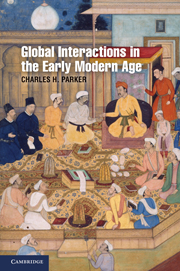Book contents
- Frontmatter
- Contents
- Maps
- Acknowledgments
- Global Interactions in the Early Modern Age, 1400–1800
- Introduction: The Global Integration of Space
- 1 European States and Overseas Empires
- 2 Asian States and Territorial Empires
- 3 International Markets and Global Exchange Networks
- 4 The Movement of Peoples and Diffusion of Cultures
- 5 The Formation of New Demographic and Ecological Structures
- 6 The Transmission of Religion and Culture
- Conclusion: Converging Destinies
- Notes
- Index
- References
Conclusion: Converging Destinies
Published online by Cambridge University Press: 05 June 2012
- Frontmatter
- Contents
- Maps
- Acknowledgments
- Global Interactions in the Early Modern Age, 1400–1800
- Introduction: The Global Integration of Space
- 1 European States and Overseas Empires
- 2 Asian States and Territorial Empires
- 3 International Markets and Global Exchange Networks
- 4 The Movement of Peoples and Diffusion of Cultures
- 5 The Formation of New Demographic and Ecological Structures
- 6 The Transmission of Religion and Culture
- Conclusion: Converging Destinies
- Notes
- Index
- References
Summary
At the end of the sixteenth century, contemporaries from around the globe expressed an unshakeable unease at what they feared were uncertain directions in world affairs. In Anatolia, the Turkish intellectual Mustafa Ali felt compelled to write a world history (The Essence of History) to make sense of all the war and social turmoil that engulfed the Ottoman Empire. Ali feared that the heyday of the empire was long past and dark days lay ahead. At roughly the same time in Madrid, Philip II of Spain lamented military losses and political rebellion exclaiming, “if this is not the end of the whole world, I think we must be very close to it.” And on the eastern edge of Eurasia in Huguang province (south central China), the governmental official Zhang Tao fretted about the corrosive social effects of commercialism. He grumbled, “As the prospect of wealth fueled avarice, the moral order that had held society together gave way…Each exploited the other and everyone publicized himself.” Given that the Ottoman, Spanish, and Chinese empires lasted into the modern age, these dire observations appear exaggerated from our vantage point in the twenty-first century. Yet there were many people in America, Asia, Africa, and Europe who believed the world was coming to an end. So, for those on the ground in the sixteenth century, the world was changing in unexpected and worrisome ways.
- Type
- Chapter
- Information
- Global Interactions in the Early Modern Age, 1400–1800 , pp. 222 - 238Publisher: Cambridge University PressPrint publication year: 2010

